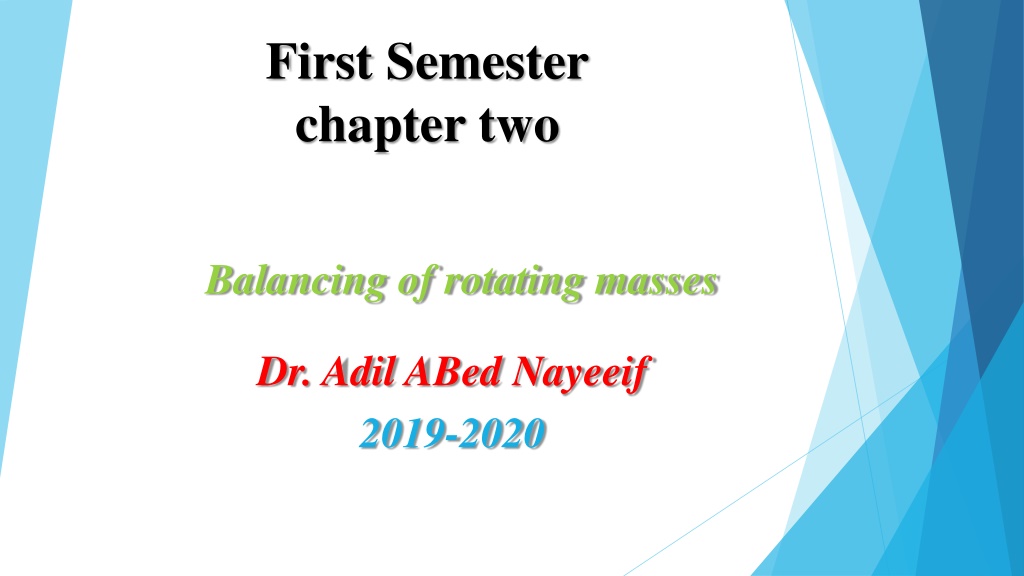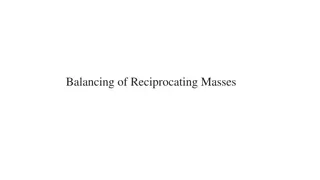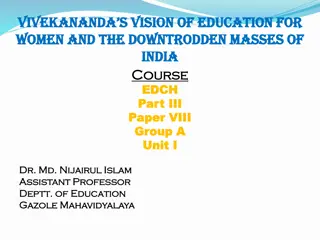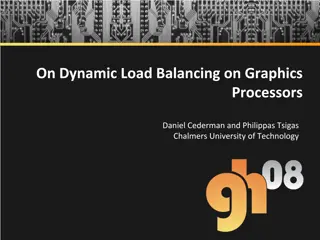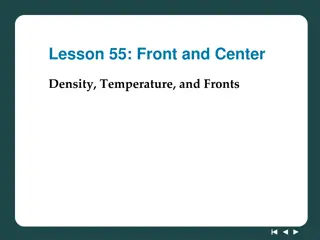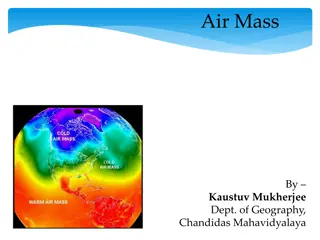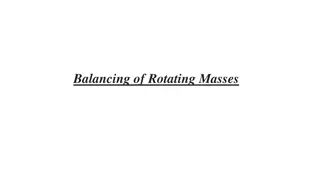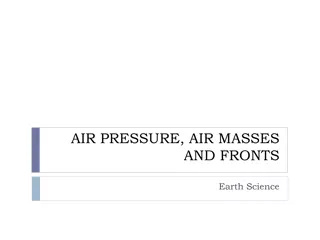Balancing of Rotating Masses in Engineering
Balancing of rotating masses is crucial in engineering to prevent the effects of centrifugal force, vibrations, and shaft bending. The process involves attaching balancing masses to counteract the centrifugal forces of the primary masses. Different cases, such as balancing in the same plane or different planes, require specific techniques for achieving equilibrium and stability in rotating systems.
Download Presentation

Please find below an Image/Link to download the presentation.
The content on the website is provided AS IS for your information and personal use only. It may not be sold, licensed, or shared on other websites without obtaining consent from the author. Download presentation by click this link. If you encounter any issues during the download, it is possible that the publisher has removed the file from their server.
E N D
Presentation Transcript
First Semester chapter two Balancing of rotating masses Dr. Adil ABed Nayeeif 2019-2020
introduction We have already discussed, that whenever a certain mass is attached to a rotating shaft, it exerts some centrifugal force, whose effect is to bend the shaft and to produce vibrations in it. In order to prevent the effect of centrifugal force, another mass is attached to the opposite side of the shaft at such a position so as to balance the effect of the centrifugal force of the first mass. This is done in such a way that the centrifugal force of both the masses are made to be equal and opposite. The process of providing the second mass in order to counteract the effect of the centrifugal force of the first mass, is called balancing of rotating masses. The following cases are important from the subject point of view: Balancing of a single rotating mass by a single mass rotating in the same plane. 1. Balancing of a single rotating mass by two masses rotating in different planes. 2. Balancing of different masses rotating in the same plane. 3. Balancing of different masses rotating in different planes. 4.
Balancing of a Single Rotating Mass By a Single Mass Rotating in the Same Plane Consider a disturbing mass m1 attached to a shaft rotating at rad/s as shown in Figure (1) Let r1 be the radius of rotation of the mass m 1 (i.e. distance between the axis of rotation of the shaft and the centre of gravity of the mass m1). We know that the centrifugal force exerted by the mass m1 on the shaft, FC1= m1 2 r1 This centrifugal force acts radially outwards and thus produces bending moment on the shaft. In order to counteract the effect of this force, a balancing mass (m2) may be attached in the same plane of rotation as that of disturbing mass (m1) such that the centrifugal forces due to the two masses are equal and opposite Figure (1)
Balancing of a Single Rotating Mass By Two Masses Rotating in Different Planes The two forces are equal in magnitude and opposite in direction. But this type of arrangement for balancing gives rise to a couple which tends to rock the shaft in its bearings Therefore in order to put the system in complete balance, two balancing masses are placed in two different planes, parallel to the plane of rotation of the disturbing mass, in such a way that they satisfy the following two conditions of equilibrium. The net dynamic force acting on the shaft is equal to zero. This requires that the line of action of three centrifugal forces must be the same. In other words, the centre of the masses of the system must lie on the axis of rotation. This is the condition for static balancing. 1. The net couple due to the dynamic forces acting on the shaft is equal to zero. In other words, the algebraic sum of the moments about any point in the plane must be zero. 2. The conditions (1) and (2) together give dynamic balancing. The following two possibilities may arise while attaching the two balancing masses : 1. The plane of the disturbing mass may be in between the planes of the two balancing masses, and 2. The plane of the disturbing mass may lie on the left or right of the two planes containing the balancing masses.
When the plane of the disturbing mass lies in between the planes of the two balancing masses Consider a disturbing mass mlying in a plane Ato be balanced by two rotating masses m1and m2 lying in two different planes L and M as shown in Figure (2). Let r, r1 and r2 be the radii of rotation of the masses in planes A, L and M respectively. l1 = Distance between the planes A and L, l2 = Distance between the planes A and M, and l = Distance between the planes L and M. We know that the centrifugal force exerted by the mass m in the plane A, FC= m 2 r Similarly, the centrifugal force exerted by the mass m1in the plane L, FC1= m1 2 r1 and, the centrifugal force exerted by the mass m2 in the plane M, FC2= m1 2 r2 Figure (2)
ince the net force acting on the shaft must be equal to zero, therefore the centrifugal force on the disturbing mass must be equal to the sum of the centrifugal forces on the balancing masses, therefore or m 2 r = m1 2 r1 +m2 2 r2 (1) FC= FC1+ FC2 m r = m1 r1 +m2 r2 Now in order to find the magnitude of balancing force in the plane L(or the dynamic force at the bearing Q of a shaft), take moments about P which is the point of intersection of the plane M and the axis of rotation. Therefore , FC1 l = FC l2 or m1 2r1 l = m 2r l2 m1r1l = m r l2 or m1 r1 = m r l2/ l (2) It may be noted that equation (1) represents the condition for static balance, but in order to achieve dynamic balance, equations (2)
Balancing of Several Masses Rotating in the Same Plane Consider any number of masses (say four) of magnitude m1, m2 , m4, and m4 at distances of r1 , r2 ,r3 , and r4 from the axis of the rotating shaft . Let 1, 2 , 3 , and 4 angles of these masses with the horizontal line OX , as shown in Figure(3). Let these masses rotate about an axis through O and perpendicular to the plane of paper, with a constant angular velocity rad/sec The magnitude and position of the balancing mass may be found out analytically or graphically as discussed below. 1. Analytical method The magnitude and direction of the balancing mass may be obtained, analytically, as discussed below 1. First of all, find out the centrifugal force 2. Resolve the centrifugal forces horizontally and verticallyand find their sums of horizontal components of the centrifugal forces, 1 = r m H + + cos cos .......... . m r 1 1 2 2 = 2 and sum of vertical components of the centrifugal forces, + + sin sin .......... . V m ( r m r 1 1 1 2 2 2 ( ) ) = + 2 2 Magnitude of the resultant centrifugal force, FC H V 3. V = tan If is the angle, which the resultant force makes with the horizontal, then 4. H The balancing force is then equal to the resultant force, but in opposite direction. 5. Now find out the magnitude of the balancing mass, such that FC= m r 6.
2. Graphical method The magnitude and position of the balancing mass may also be obtained graphically as discussed below: First of all, draw the space diagram with the positions of the several masses, as shown in figure (3). 1. Find out the centrifugal force (or product of the mass and radius of rotation) exerted by each mass on the rotating shaft. 2. Now draw the vector diagram with the obtained centrifugal forces (or the product of the masses and their radii of rotation), such that ab represents the centrifugal force exerted by the mass m1 or (m1r1) in magnitude and direction to some suitable scale. Similarly, draw bc, cd and de to represent centrifugal forces of other masses m2 , m3 , and m4 or (m2r2 , m3r3 , and m4r4). 3. Now, as per polygon law of forces, the closing side ae represents the resultant force in magnitude and direction, as shown in figure (3). 4. The balancing force is, then, equal to the resultant force, but in opposite direction. 5. Now find out the magnitude of the balancing mass (m) at a given radius of rotation (r) 6. Figure(3)
Balancing of Several Masses Rotating in Different Planes When several masses revolve in different planes, they may be transferred to a reference plane (briefly written as R.P.), which may be defined as the plane passing through a point on the axis of rotation and perpendicular to it. The effect of transferring a revolving mass (in one plane) to a reference plane is to cause a force of magnitude equal to the centrifugal force of the revolving mass to act in the reference plane, together with a couple of magnitude equal to the product of the force and the distance between the plane of rotation and the reference plane. In order to have a complete balance of the several revolving masses in different planes, the following two conditions must be satisfied : The forces in the reference plane must balance i.e. the resultant force must be zero. 1. The couples about the reference plane must balance i.e. the resultant couple must be zero. 2. Let us now consider four masses m1 , m2 , m3 , and m4 revolving in planes 1, 2, 3 and 4 respectively as shown in figure (4) The relative angular positions of these masses are shown in the end view The magnitude of the balancing masses mL and mM in planes L and M may be obtained as discussed below: Take one of the planes, say L as the reference plane (R.P.). The distances of all the other planes to the left of the reference plane may be regarded as negative, and those to the right as positive. 1. Tabulate the data as shown in Table(1) 2.
Examples Ex(1) Four masses A, B, C and D as shown below are to be completely balanced. A - B 30 240 C 50 120 D 40 150 Mass (kg) Radius (mm) 180 The planes containing masses B and C are 300 mm apart. The angle between planes containing B and C is 90 . B and C make angles of 210 and 120 respectively with D in the same sense. Find The magnitude and the angular position of mass A ; and 1. The position of planes A and D. 2. Solution. Given : rA = 180 mm=0.18m , mB = 30kg , rB = 240 mm = 0.24 m , mC = 50 kg , rC = 120 mm = 0.12 m , mD = 40 kg , rD = 150 mm = 0.15 m, BOC = 90o , BOD = 210 o , COD = 120o The magnitude and the angular position of mass A 1. Let mA : magnitude of mass A x: Distance between the planes B and D, and y: Distance between the planes A and B.
The position of the planes and the angular position of the masses is shown figures (a) and (b) respectively Assuming the plane B as the reference plane (R.P.) and the mass B (mB) along the horizontal line as shown in figure (b) The magnitude and angular position of mass A may be determined by drawing the force polygon from the data given in Table above (Column 4), as shown in figure (c) , to some suitable scale. Since the masses are to be completely balanced, therefore the force polygon must be a closed figure. The closing side (i.e. vector do) is proportional to 0.18 mA By measurement. 0.18 mA= Vector do = 3.6 kg-m or mA= 20 kgAns. AOB = 236 Ans.
2. Position of planes A and D The position of planes Aand Dmay be obtained by drawing the couple polygon, as shown in figure (d). from the data given in Table (column 6). The couple polygon is drawn as discussed below : Draw vector o c parallel to OC and equal to 1.8 kg-m2, to some suitable scale . 1. From points c and o , draw lines parallel to OD and OA respectively, such that they intersect at point d . By measurement, we find that 6 x = vector c d = 2.3 kg-m2 or x = 0.383 m. 2. We see from the couple polygon that the direction of vector c d is opposite to the direction of mass D. Therefore the plane of mass D is 0.383 m or 383 mm towards left of plane B and not towards right of plane B as already assumed. Ans. Again by measurement from couple polygon, 0.18 mA.y = vector o d = 3.6 kg-m2 0.18 20 y = 3.6 or y = 1 m The negative sign indicates that the plane A is not towards left of B as assumed but it is 1 m or 1000 mm towards right of plane B. Ans.
Ex(2) A shaft has three eccentrics, each 75 mm diameter and 25 mm thick, machined in one piece with the shaft. The central planes of the eccentric are 60 mm apart. The distance of the centres from the axis of rotation are 12 mm, 18 mm and 12 mm and their angular positions are 120 apart. The density of metal is 7000 kg/m3 Find the amount of out-of-balance force and couple at 600 r.p.m. If the shaft is balanced by adding two masses at a radius 75 mm and at distances of 100 mm from the central plane of the middle eccentric, find the amount of the masses and their angular positions. Solution. Given : D = 75 mm = 0.075 m ; = 25 mm = 0.025 m ; rA= 12 mm = 0.012 m ; rB= 18 mm = 0.018 m ; rC= 12 mm = 0.012 mm ; = 7000 kg/m3 ; N = 600 r.p.m. or =2 600/60=62.84 rad/s rL = rM = 75 mm = 0.075 m. We know that mass of each eccentric mA= mB= mC= Volume Density, Let L and M be the planes at distances of 100 mm from the central plane of middle eccentric. The position of the planes and the angular position of the three eccentrics is shown in figures(a) and (b) respectively. Assuming L as the reference plane and mass of the eccentric A in the vertical direction, the data may be tabulated as below :
The out-of-balance force is obtained by drawing the force polygon, as shown in Figure below
Since the centrifugal force is proportional to the product of mass and radius (i.e. m.r), therefore by measurement. Out-of-balance force = vector oc = 4.75 10-03 kg-m
Out-of-balance couple The out-of-balance couple is obtained by drawing the couple polygon from the data given in table previous (column 6), as shown in Figure(d). The resultant o c represents the out of balance couple. Since the couple is proportional to the product of force a,nd distance (m.r.l), therefore by measurement. Out-of-balance couple = vector o c = 1.1 10-03 kg-m2. = 1.1. 10-03. 2 = 1.1 10-03 (62.84)2 = 4.34 N-m Ans. Amount of balancing masses and their angular positions The vector c o (in the direction from c to o ), as shown in Figure (d) .represents the balancing couple and is proportional to 15 10-03 mM, i.e. 15 10 3 mM= vector c o = 1.1 10-03kg-m2 mM = 0.073 kg Ans. Draw OM in Figure (b) parallel to vector c o . By measurement, we find that the angular position of balancing mass (mM) is 5 from mass A in the clockwise direction. Ans. In order to find the balancing mass (m1), a force polygon as shown figure (e) is drawn. The closing side of the polygon i.e. vector do (in the direction from d to o) represents the balancing force and is proportional to 75 10-3 mL By measurement, we find that 75 10-3 mL = vector do = 5.2 10-3 kg-m mL = 0.0693 kg Ans. Draw OL in Figure (b), parallel to vector do. By measurement, we find that the angular position of mass (mL) is 124o from mass A in the clockwise direction. Ans.
Ex(3): A shaft is supported in bearings 1.8 m apart and projects 0.45 m beyond bearings at each end. The shaft carries three pulleys one at each end and one at the middle of its length. The mass of end pulleys is 48 kg and 20 kg and their centre of gravity are 15 mm and 12.5 mm respectively from the shaft axis. The centre pulley has a mass of 56 kg and its centre of gravity is 15 mm from the shaft axis. If the pulleys are arranged so as to give static balance, determine : 1. relative angular positions of the pulleys, and 2. dynamic forces produced on the bearings when the shaft rotates at 300 r.p.m. Solution. Given : mA = 48 kg ; mC = 20 kg ; rA = 15 mm = 0.015 m ; rC = 12.5 mm = 0.0125 m ; mB = 56 kg ; rB = 15 mm = 0.015 m ; N = 300 r.p.m. or = 2 300/60 = 31.42 rad/s. Relative angular position of the pulleys 1. The position of the shaft and pulleys is shown in Figure (a). Let mL and mM = Mass at the bearings L and M, and rL and rM = Radius of rotation of the masses at L and M respectively Assuming the plane of bearing L as reference plane, the data may be tabulated as below :
First of all, draw the force polygon to some suitable scale, as shown in Figure (c), from the data given in (column 4). It is assumed that the mass of pulley B acts in vertical direction. We know that for the static balance of the pulleys, the centre of gravity of the system must lie on the axis of rotation. Therefore a force polygon must be a closed figure. Now in Figure (b), draw OA parallel to vector bc and OC parallel to vector co. By measurement, we find that Angle between pulleys B and A = 161 Ans. Angle between pulleys A and C = 76 Ans. and Angle between pulleys C and B = 123 Ans.
Dynamic forces at the two bearings 2. In order to find the dynamic forces (or reactions) at the two bearings L and M, let us firs calculate the values of mL .rL and mM .rM as discussed below :
Draw the couple polygon to some suitable scale, as shown in Figure (d), from the data given in Table above (column 6). The closing side of the polygon (vector c o ) represents the balanced couple and is proportional to 1.8 mM .rM . By measurement, we find that 1.8 mM .rM= vector c o = 0.97 kg-m2 or mM .rM = 0.54 kg-m 1. Dynamic force at the bearing M , = 2 2 mM.rM. = 0.54 (31.42) = 533 N Ans. Now draw the force polygon, as shown in Figure (e), from the data given in Table (column 4) and taking mM .rM = 0.54 kg-m. The closing side of the polygon (vector do) represents the balanced force and is proportional to mL .rL . By measurement, we find that mL .rL = 0.54 kg-m 2. Dynamic force at the bearing L, = 2 mL .rL . = 0.54 (31.42)2 = 533 NAns. From couple polygon as shown in Figure(d), we see that the vector o c in the direction from o to c represents the out-of-balance couple. By measurement, we find that Out-of-balance couple = vector o c = 0.7 kg-m2 = 0.97 2= 0.97 (31.42)2= 957.6 N-m 957 6 . out tan of balance couple Dynamic force on each bearing = = = 532 N 8 . 1 dis ce between bearing
Exercises Q1/ The camshaft of high speed pump consists of a parallel shaft 25 mm diameter and 480 mm long. It carries three eccentrics, each of diameter 60 mm and a uniform thickness of 18 mm. The assembly is symmetrical as shown in Figure(Q1) and the bearings are at Aand B. The angle between the eccentrics is 120 and the eccentricity of each is 12.5 mm. The material density is 7000 kg/m3, and the speed of rotation is 1430 r.p.m. Find : 1. dynamic load on each bearing due to the out-of-balance couple ; and 2. kinetic energy of the complete assembly.
Q2/ The out of balance of a machine rotor is equivalent to 5 kg at 10 mm radius in one plane A, together with an equal mass at 15 mm radius in a second plane B. AB = 375 mm and the two radii are 120o. Find the mass required in third plane C at a radius of 125 mm and its angular position with respect to the given radii so that there is no resultant out of balance force. Find also the position of C along the axis for the residual couple to be a minimum and of this couple when the speed is 500 r.p.m. Q3/ A three throw cranks shaft has double webbed cranks of 150 mm radius set at 120oto each other and equally spaced with a pitch of 500 mm. the rotating masses at crank radius are: No. 1, 30 kg ; No. 2, 40 kg ; No.3, 40 kg. Balance is to be effected by a balance mass attached to the outside web of crank No.1, with a cntre of mass 150 mm from the central plane of the crank and a radius of 225 mm from the centre of the shaft; and also by removing material, at a radius of 750 mm, from a wheel fixed 750 mm beyond the central plane of crank No.3. Determine the masses to be fitted and removed and their angular positions relative to crank No.1.
